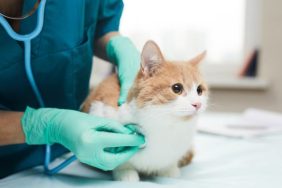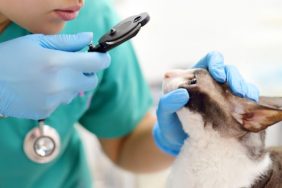This article courtesy of PetMD.com.
(Picture Credit: Getty Images)Congenital and Developmental Renal Diseases in Cats
Congenital (existing at birth) and developmental kidney diseases are part of a group of diseases in which the kidney may be abnormal in its ability to function normally, or may be abnormal in appearance, or both. These diseases result from inherited or genetic problems or disease processes that affect the development and growth of the kidney before or shortly after birth. Most patients are less than five years of age at the time of diagnosis.
Symptoms and Types
Symptoms:
- Lack of appetite
- Lack of energy
- Excessive urination
- Excessive thirst
- Weight loss
- Vomiting
- Abdominal enlargement
- Bloody urine
- Abdominal pain
- Fluid-build up under the skin
Types:
- Failure of kidney formation (renal agenesis)
- Complete absence of one or both kidneys
- Abnormal kidney development (renal dysplasia)
- Displacement of one or both kidneys (renal ectopia)
- Glomerulopathy (disease of the group of small blood vessels in the functional unit of the kidney)
- Kidney disease involving the tubules and tissue spaces (tubulointerstitial nephropathy)
- Polycystic kidney disease, characterized by formation of multiple, variable-sized cysts throughout the kidney tissue
- Dilation of small blood vessels in the kidney (renal telangiectasia), characterized by multiple blood vessel malformations involving the kidneys and other organs
- Amyloidosis of the kidney, is a group of conditions of differing causes in which insoluble proteins (amyloids) are deposited outside of cells in various tissues and organs, compromising their normal function
- Nephroblastoma (a congenital kidney tumor)
- Fanconi syndrome, a generalized functional abnormality involving the tubules of the kidney, characterized by impaired reabsorption
- Presence of glucose in the urine due to primary kidney disease (primary renal glucosuria)
- Cystinuria, excessive excretion of cystine (an amino acid) into the urine
- Xanthinuria, excessive excretion of xanthine into the urine
- Hyperuricuria, excessive excretion of uric acid, sodium urate, or ammonium urate into the urine
- Primary hyperoxaluria, a disorder characterized by intermittent high levels of oxalic acid or oxalates in the urine
- Congenital nephrogenic diabetes insipidus, a disorder of kidney concentrating ability, caused by diminished kidney responsiveness to an antidiuretic hormone, such that excessive urine is produced
Causes
- Hereditary
- Infectious agents may cause renal dysplasia
- Feline panleukopenia virus
- Drugs
- Dietary factors
Diagnosis
Your veterinarian will perform a thorough physical exam on your cat, taking into account the background history of symptoms and any possible incidents that might have led to this condition. You will need to give a thorough history of your cat’s health, onset of symptoms, and any information on your cat’s family history that you are familiar with. Your veterinarian will order a blood chemical profile, a complete blood count, an electrolyte panel, and a urinalysis. Abdominal x-rays, abdominal ultrasound and an excretory urography (x-ray of your cat urinating) will all be performed to identify and characterize the kidney disease your cat is suffering form. There are some direct genetic tests that are available for detection of specific genetic mutations associated with familial polycystic renal disease in Persian and Persian-derived breeds of cats.
Treatment
Treatment for patients suffering from kidney disorders is often supportive or symptomatic. Without a kidney transplant, there is no cure for developmental or congenital kidney disease. Cats with high blood pressure should be switched to a low salt diet, and cats with chronic kidney failure should have phosphorous restricted and protein intake moderately restricted.
Living and Management
Your veterinarian will schedule follow-up appointments for your cat to monitor the progression of the kidney disease. Animals with developmental or congenital kidney disease should not be bred; neutering is highly advised under these conditions.
This article originally appeared here on PetMD.com.









